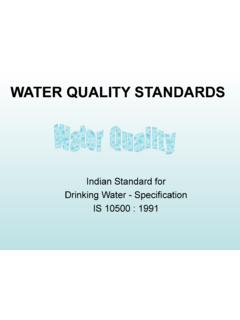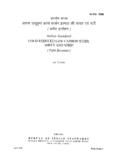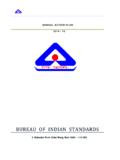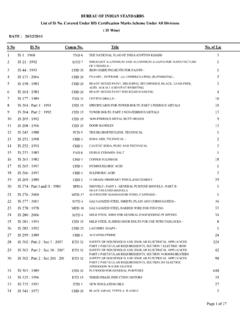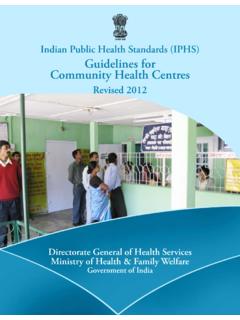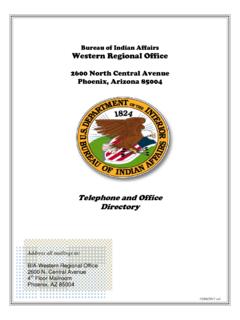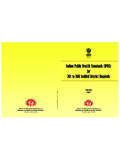Transcription of DIETARY GUIDELINES - National Institute of Nutrition
1 DIETARY GUIDELINES FOR INDIANS-A Manual National Institute OF NUTRITIONH yderabad 500 007, INDIAF irst Published .. 1998 Reprinted .. 1999, 2003, 2005, 2007 Second Edition .. 2011 ATTENTION READERSR eaders can download the soft copy of the DIETARY GUIDELINES for Indians free of cost for their own use and also for dissemination of information for the benefit of the society on non-profit basis. Readers are not supposed to either reproduce / copy / reprint the same for commercial purpose. If the information is used in some context, the source of information with proper acknowledgement to the National Institute of Nutrition , Hyderabad should be mentioned.
2 Usage of the information should be intimated to the Director, NIN in advance and approval should be sought. All copyrights are reserved with NIN. WORKING GROUP OF THE FIRST EDITIONN ational Institute of Director (Sr. Grade) Director (Sr. Grade)Dr. GhafoorunissaDeputy Director (Sr. Grade)Dr. Raghuram Director (Sr. Grade)Dr. Raghuramulu Director (Sr. Grade)Dr. Sivakumar Director (Sr. Grade) Director (Sr. Grade)Assistance rendered by K, Mr. Pulkit Mathur, Ms. Sujatha T, Ms. Uma NayakDr. Vasanthi S and Dr. Vijayalakshmi K, in the preparation of Annexures is gratefully ADVISORY GROUP OF THE FIRST EDITIONDr. Achaya KT. Dr. Rajammal P DevadasCSIR Emeritus-Scientist ChancellorBangalore Avinashalingam deemed University CoimbatoreDr.
3 Bamji. Mahtab S. Dr. Ramachandran Director-Grade Scientist, NIN Diabetes research CentreICMR Emeritus scientistChennaiHyderabadDr. Bhan MK. Dr. Rao MVAdditional Professor Former Vice-ChancellorAll India Institute of Medical Sciences UniversityNew Delhi HyderabadDr. Leela Raman Dr. Srinath Reddy Deputy Director ( ), NIN Prof. CardiologyHyderabad All India Institute of Medical SciencesNew DelhiDr. Mary Mammen Dr. Subhadra SeshadriChief DietitianHead, Dept.
4 Of Food & NutritionChristian Medical College & Hospital UniversityVellore BarodaDr. Narasinga Rao BS. Dr. Sushma SharmaFormer Director, NIN Reader in NutritionHyderabad Lady Irwin CollegeNew DelhiDr. Pralhad Rao Vinodini ReddyFormer Deputy Director ( ), NINF ormer Director, NINH yderabad HyderabadDr. Prema Ramchandran Adviser (Health)Planning CommissionNew DelhiWORKING GROUP OF THE SECOND EDITIONN ational Institute of NutritionHyderabadDr. Kamala Director, Director, Kumar L. M. Kalpagam Rao rendered by the artist Mr. S. Devendran in designing the revised edition; Ramarao for technical assistance; Mr. B. Omprakash, Mr.
5 N. Satyanarayana and Mr. V. Bhuvaneswaran of the Printing Division, NIN is gratefully are thankful to Food and Nutrition Security Community Solution Exchange GroupandDr. Anura Kurpad, Dean, St. John s Research Institute , Bangalore for their valuable comments and inputs. CONTENTSPageForewordiPrefaceiiIntroducti on 1 Current Diet and Nutrition Scenario 3 DIETARY Goals9 DIETARY Guidelines10 Guideline 1 11 Guideline 221 Guideline 325 Guideline 429 Guideline 534 Guideline 640 Guideline 745 Guideline 852 Guideline 956 Guideline 1060 Guideline 1163 Guideline 1267 Guideline 1370 Guideline 1475 Guideline 1579 Annexures 1. Approximate Calorific Value of Nuts, Salads and Fruits852. Balanced Diet for Adults - Sedentary/Moderate/Heavy Activity86 2a. Sample Meal Plan for Adult Man (sedentary)87 2b.
6 Sample Meal Plan for Adult Woman (sedentary)883. Recommended DIETARY Allowances Macronutrients89 Micronutrients904. Balanced Diet for Infants, Children and Adolescents915. Anthropometric Standards926. Low Calorie Vegetables and Fruits (< 100 Kcal)1047. Vegetable and Fruits with High Calorie Value (> 100 Kcal)1058. Approximate Calorific Value of Some Cooked Preparations1069. ALA Content of Foods (g/100g) Index of Common and Physical of the Pesticide Residues from the Food Water Sizes and Menu Nutrient-rich Foods118 BOOKS FOR FURTHER READING121 GLOSSARY 123 FOREWORDIt is now more than a decade since this valuable publication was first prepared.
7 It was compiled by a team of experienced Nutrition scientists at the National Institute of Nutrition , Hyderabad, under the leadership of Dr. Kamala Krishnaswamy. It has received wide appreciation from the general public as well as from students of Nutrition , medicine, home science, nursing and allied subjects, and has been reprinted several times. It has also been widely disseminated through outreach activities undertaken by the National Institute of Nutrition , in the form of lectures, exhibitions and distribution of materials in various local the intervening years, there have been notable socio-economic changes in India. It was thought necessary to update the GUIDELINES in the light of new developments and fresh most notable change has been in the overall economic scenario in the country, with a robust growth rate.
8 There have also been some important government initiatives in the fields of health and Nutrition and poverty alleviation, including the launching of MGNREGA and overhauling of the ICDS. Globalisation has resulted in the opening of multinational fast food chains in Indian cities, including the smaller cities. Lifestyles and DIETARY patterns that had started giving early warning signals towards the end of the previous century, when these GUIDELINES were first published, are continuing to follow a trend that promotes obesity and the attendant non communicable improvement in the overall economy at the macro level and concomitant improvements in purchasing power (though unevenly distributed) among households have not led to the expected levels of improvement in the nutritional status of Indians.
9 The latest findings of the National Family Health Survey, NFHS-3 showed virtually no improvement in parameters as compared to NFHS-2, and recent surveys by the National Nutrition Monitoring Bureau have thrown more light on the growing problem of the 'double burden' of undernutrition and overnutrition. These data should serve as a wake-up call to nutritionists and policy makers. There is very obviously an 'awareness and information deficit', even among the more affluent sections of the population, about good DIETARY practices and their linkage with good health. This deficit should be narrowed and eliminated by harnessing all traditional as well as modern technological vehicles of updated version of DGI from India's premier Nutrition Institute , National Institute of Nutrition , should serve as a valuable source of concise, accurate and accessible information, both for members of the general public and those who are involved in dissemination of Nutrition and health education.
10 - Dr. C. GOPALANF ounder President Nutrition Foundation of IndiaPREFACEThe first edition of ' DIETARY GUIDELINES ' was published in 1998, and since then many changes have taken place in the country. The economic transition has transformed the way people live. Changing lifestyles of people both in rural and urban areas are seen to alter the very structure of our society at a rapid pace today. The shift from traditional to 'modern' foods, changing cooking practices, increased intake of processed and ready-to-eat foods, intensive marketing of junk foods and 'health' beverages have affected people's perception of foods as well as their DIETARY behaviour. Irrational preference for energy-dense foods and those with high sugar and salt content pose a serious health risk to the people, especially children.

